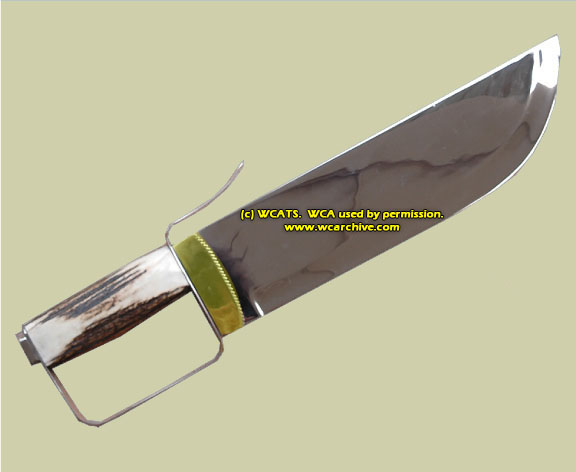|
Sword Terminology
by Danny Yinsheng Xuan
About Bat Jum Dao
Although
Bat Jum Dao parts are similar to Western swords, there are some
terms that require adaptations. For the purpose of
clarifications with sword terminologies, I'm presenting some for
your reference when reading my articles.
The Sword
A sword is sectioned into two parts: the blade and the hilt.
See the picture below. The Blade, outlined in green, is the
metal part that is used for cutting, slicing, thrusting. The
Hilt, outlined in yellow, is everything other than the blade.

The Blade
The blade consists of the Back (outlined in green), sometimes
called the Spine, if it is a single-edge sword like the Bat Jum
Dao. The Point, sometimes called the Tip, is located at the
front of the blade. The shape of a Bat Jum Dao blade is called
Hatched Point (marked in yellow). The sharp side of the sword is
called the Edge (marked in blue). The unsharpened part of the edge,
near the hilt, is called the Ricasso (marked in white). The flat
sides of the blade is referred to as the Flat (shaded in pink).

The Hilt
The Hilt consists of the Grip, Tang, and Handguard. The Grip,
sometimes called the Handle (highlighted in yellow), is where
one holds the sword for wielding; the Tang, which is an
extension of the blade, is usually enclosed and hidden inside
the grip. The Pommel (highlighted in white) holds the blade and
hilt together. The Handguard (highlighted in green) consists of
everything made to protect the hand; which are, the Knuckle Bow
(highlighted in blue), which bows around the back of the hand;
the Quillon (highlighted in pink), which protects the hand
directly behind the blade; and the Finial (highlighted in
orange), which extends from the quillon, and is used to trap an
opponent's weapon.

The Langet
Since the Bat Jum Dao design is very different from Western
swords, it is difficult to put specific Western names for some
parts. For example, the finial in a Western sword is just a
small decorative extension of the quillon. In the Wing Chun's
BJD, the quillon extension is long, and is used for trapping
opponents' weapons. I was tempted to call the BJD quillon
extension "langet," as it looks more like a Western langet.
However, the langet on a Western sword is used only to lock a
sword onto its scabbard. Some langets are located along the
spine of the blade (like BJD quillon extension); some are
located on the flat side of the blade. Below is a picture of a
BatJumDao I designed, with Western style langets on the flat
side (highlighted in yellow) to double as scabbardlock and
bladetrap.

The Tang
As mentioned above, the Tang is usually hidden inside the
grip; however, here's a 2-in-1 Bat Jum Dao design which exposes
the Tang design. In this case, the tang is called Full Tang
(highlighted in red in the picture below). Also note that the
blade part that meets the tang is called the Shoulder
(highlighted in green). Each corner can be referred to as
"Shoulder" as well.

There are several types of Tang designs, as shown in the
picture below.

The Scabbard
There are many designs of sword scabbards and sheaths. It is
all left to the imagination of the bladesmith or swordsman.
Generally, a scabbard includes a body, or case (highlighted in
yellow in the picture below), and a throat (highlighted in
green). The picture below shows two throats for two Bat Jum Daos.

Copyright (c) 2005 the Wing Chun Archive and
Danny Xuan 10/26/05 |
